
If you are like most marketers, you probably don’t measure your content marketing properly.
You may even ask yourself:
“Is my content marketing driving revenue? And if so, how do I know if it does?”
The thing is …
Whatever your industry, your customers are constantly asking Google questions your business can solve:
“Best plus size dresses with sleeves below £80”
“How can I invest £1,000 risk-free”
“How can I do keyword research without paying for a software”
If you’re not visible to your customers when they need you most, you lose out on increasing your revenue.
Answering these questions is your opportunity to grab your potential customers’ attention at the time they start thinking about your products.
So, creating a blog strategy to drive all that qualified traffic is an excellent top-funnel vehicle, where you can get in front of as many potential buyers as possible.
Content Marketing and the Importance of Sales Funnels
The 2 biggest problems we see Digivate clients make when measuring their content marketing success is:
- Not understanding their sales cycle and how their customers buy
- Over-estimating the value of top-funnel (awareness stage) content
Unfortunately, you can’t measure your content marketing success if you don’t understand your customer journey and how they buy.
Today, people engage with your business several times before converting.
Here is just one example of a typical customer journey within a long-buying cycle:
1st TOUCHPOINT: Mike reads your blog post, which he landed on via Google search
2nd TOUCHPOINT: A week later Mike clicks on the retargeting ad he sees on Facebook
3rd TOUCHPOINT: Mike goes on to discover more content on your site and downloads a PDF (he is now on your email list)
4th TOUCHPOINT: Mike finally converts after engaging with 3 personalised emails
As you can see from the example above, Mike wouldn’t have converted after reading a blog post the first time, which means that there is little use in measuring your content marketing ROI at the awareness stage.
You also need to create a content marketing plan for the middle funnel, where customers consider and evaluate your service or product and compare it to your competitors.
As a CMO or marketing manager, your main objective is not to prove ROI on your top funnel blogging activities, but to show that you are turning the initial customer interest into a lead and a lead into a sale. Content marketing ROI can only be measured in stages.
How to Measure Content Marketing ROI at Different Buyer Stages
Why should the customer journey be considered when measuring the performance of your content strategy?
Because at any moment in your sales funnel, there is always a group of people unaware that your product can solve their problem; there is another group aware of your business but are evaluating their options and finally – there is a group that is ready to buy.
This means that at any time, your business has the potential to attract 3 types of customers:
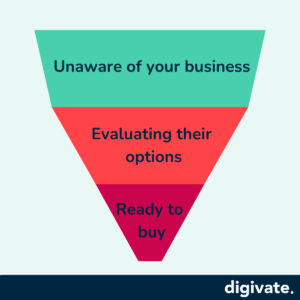
If you only concentrate on acquiring new customers, you are losing out on other revenue streams.
You can’t measure your content marketing ROI without measuring success at each buyer stage. ROI can only be measured as a cumulative effect of different marketing activities.
To give you a tangible example of what exactly you can measure at each buyer stage, here are some examples:
Awareness Stage (Top Funnel)
At the awareness stage, you want as many new potential buyers as possible to SEE your content.
At this stage, visitors aren’t aware of your brand, and they certainly aren’t aware of the solution you have to offer them.
They are just looking for answers, resources, opinions, and insights, with no special goal in mind.
The content created here is designed to be problem-solving to facilitate awareness.
The awareness content takes any form depending on what your audience prefers, for example, articles, podcasts, and videos.
Meaningful metrics to track at the awareness stage:
- Traffic
- Dwell time/Time spent engaging with content
Why engagement (dwell time) is crucial at the awareness stage? Because it’s almost impossible to turn an uninterested visitor into a lead. The ultimate purpose of the awareness stage is to drive visitors down to the consideration stage.
Side note: If your goal is to grow your social media accounts, you may also want to measure social engagement – Likes, shares, comments and follower growth.
Consideration/Evaluation Stage (Middle Funnel)
This is a lead generation stage.
As the journey cycle of your prospect changes, your content should change too.
Here you need to determine what a lead means to you and then create a lead magnet. A lead magnet is any valuable resource your target audience wants. A lead magnet can be a downloadable, time-sensitive offer, trial or anything else.
You want people to take some sort of action without spending money – they need to do something specific for us to classify them as a lead.
The only meaningful metric to track at the consideration stage:
- No. of qualified leads
Action Stage (Bottom Funnel)
The ultimate goal here is to convert qualified leads into paying customers. As such, the content produced here should facilitate conversions.
Examples of content at the action stage are comparison sheets, reviews, demos, product pages, customer stories, and testimonials.
The only meaningful metric to track at the action stage:
- No. of conversions
If you are not creating and promoting content across all 3 buyer stages, then you aren’t able to measure the performance of your content marketing strategy.
Unfortunately, many companies stop their marketing efforts by producing content only for the first stage of the marketing funnel. As a result of this incomplete strategy, they miss out on better business conversions and proving their positive ROI.
What is a Marketing Attribution Model and How Does It Help With ROI
A marketing attribution model is a framework for deciding which customer touchpoints receive credit for a conversion.
A marketing attribution model is used for tracking performance across all digital marketing channels: organic and paid search, organic and paid social, referral, direct, email, content reads, downloads, etc.
To put it in a real-life context, let’s say you released important industry research last month. You promoted it on social media, and search and you sent the report to your blog subscribers.
You can see that your conversions have increased, but you have no idea which channel drove the best results? By knowing which channel drove the most conversions, you know where you should allocate more budget to.
As a marketing manager, your main objective is to justify your content marketing investment to your stakeholders, which means that you have to prove a positive return on investment (ROI).
But how do you do it?
How do you know which marketing touchpoints actually assisted in sales?
Luckily, there are several marketing attribution models that help to measure how each customer touchpoint assisted in multi-channel selling.
Previously, Google Analytics had 5 commonly used attribution models:
- First-click attribution
- Last-click attribution
- Linear attribution
- Time-decay attribution
- Position-based attribution
Let’s look at the best use cases for different attribution models in more detail …
1. First-click attribution
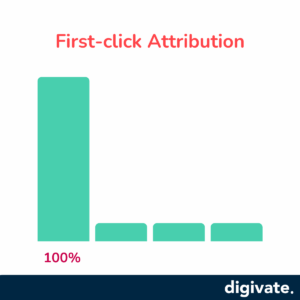
A first-click attribution assigns 100% of revenue to the first channel the lead clicked on and ignores all the rest. The logic with this model is simple: no sale is ever made if a customer doesn’t know you exist.
The best use case for a first-click attribution model
Use a first-click attribution model if your sole goal is demand generation and brand awareness and if your sales cycles are short.
2. Last-click attribution
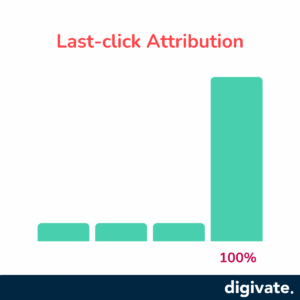
A last-click model assigns 100% of revenue to the last customer touchpoint before purchase and ignores all the steps that were taken up until the point of conversion. For example, previous visits to the site via blog traffic, nurturing emails, retargeting ads could receive no credit, even if they did play a part in the customer journey.
The best use case for a last-click attribution model
Use a last-click attribution if you want to reach someone at the time of purchase and your if your sales cycles are short.
3. Linear attribution
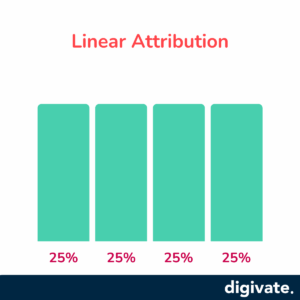
A linear attribution model divides equal credit between all touchpoints. This model assumes that all customer touchpoints are equally important. This type of model allows you to get a more complete picture without having to build a complex, algorithmic model.
The best use case for a linear attribution model
Use a linear attribution model if your sales cycles are long, your marketing plan requires you to consistently keep in touch with your customers or you want a quick off-the-shelf solution without having to build a custom-model.
4. Time-decay attribution
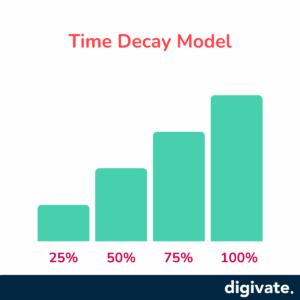
Time decay attribution assigns more credit to touchpoints closer to the point of conversion. The logic here is simple: the recent interactions are worth more because each touchpoint brings a prospect closer to conversion
The best use case for the time decay attribution model
Use time decay attribution for timed promotional campaigns because it rightfully devalues the early parts of the campaign that didn’t convert the lead.
5. Position-based attribution
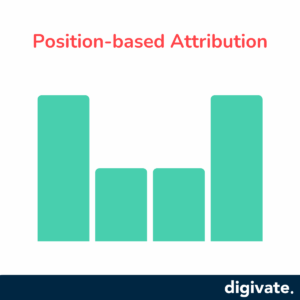
A position-based attribution model (also known as U-shaped attribution) gives more credit to the first and last touch interactions. 40% of the value is given to both – the first and last interaction, and the remaining 20% is attributed to the channels in the middle. The logic here is simple: the 2 most important touchpoints are the moment a customer finds you and the moment they buy.
The best use case for a position-based attribution model
Use a position-based attribution if your sales cycle is long and you are in a competitive market.
The 3 Attribution Models with GA4
Now in GA4, there are only 3 attribution models and those are:
- Data-driven attribution
- Paid and organic last click
- Google paid channels last click
1. Data-driven attribution
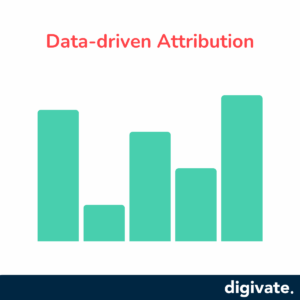
A data-driven attribution model uses advanced machine learning algorithms to distribute credit across all the touchpoints in a customer’s journey based on data specific to your business. Unlike rule-based models like last-click or linear attribution, the data-driven model adjusts dynamically using your actual performance data. It evaluates both converting and non-converting paths to understand the true impact of each interaction on key events, such as a purchase or lead generation.
The best use case for a data-driven attribution model
Use data-driven attribution if you want to maximise the accuracy of your attribution model and you have enough data for machine learning algorithms to evaluate. This model is ideal if you’re running campaigns across multiple channels and need to understand the exact contribution of each touchpoint, especially when looking for long-term optimization.
Paid and organic last-click attribution / last non-direct click
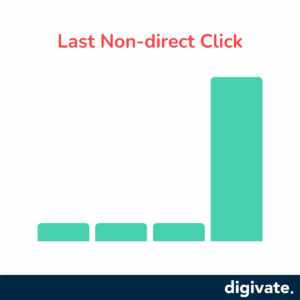
The paid and organic last-click attribution model attributes 100% of the conversion credit to the last non-direct channel a user clicked on before making a purchase or completing a key event. This model ignores direct traffic, such as when a user types your URL directly into the browser, and focuses instead on the last marketing channel—whether paid (such as Google Ads) or organic (such as SEO)—that led the user to convert.
The best use case for paid and organic last-click attribution
This model is ideal if you want to analyse the immediate impact of your marketing efforts at the final touchpoint before conversion, especially for businesses that leverage a combination of paid and organic channels. It’s a straightforward approach for understanding which non-direct touchpoint plays the final role in driving conversions, making it useful for marketers who focus on the last action customers take before completing a key event. However, it does not account for the influence of earlier touchpoints, which may also contribute to the overall customer journey.
Google paid channels last click
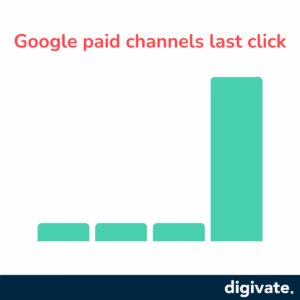
In a Google paid channels last-click attribution model, 100% of the credit for a key event is assigned to the last interaction through a Google Ads channel before a customer converts. If there is no Google Ads click present in the user’s path, the model defaults to the “paid and organic last-click” approach, which credits the last non-direct channel before conversion.
The best use case for Google paid channels last click
This model is best when you’re primarily using Google Ads as a key driver for your conversion strategy and you want to track the effectiveness of your paid campaigns without considering non-Google touchpoints. It offers a simplified, Google-centric view of attribution that works well when Google Ads play a dominant role in your overall marketing mix.
5 Cracking Strategies To Improve Your Content Marketing ROI
Investing in content marketing can be one of the most cost-effective ways to grow your business—but how do you ensure you’re getting a solid return on investment (ROI)? If you’re spending time and resources creating content that isn’t generating leads, boosting traffic, or increasing sales, it’s time to tweak your strategy.
The good news is that there are actionable ways to improve your content marketing ROI, and we’re going to break down some powerful strategies that can make a significant difference.
1. Focus on Data-Driven Content Creation
The days of “just writing” are long gone. For real results, your content creation needs to be driven by data. Analyse your audience demographics, behaviour, and preferences to tailor your content to what resonates best. Use tools like Google Analytics, Semrush, and HubSpot to gather insights into your readers’ interests, pain points, and content consumption patterns. This way, every blog post, social media update, or email campaign is designed to hit the mark.
2. Create Evergreen Content for Longevity
Evergreen content is the gift that keeps on giving. Unlike trendy posts that quickly lose relevance, evergreen content stays valuable and attracts visitors long after it’s been published. Topics like “how-tos,” FAQs, and ultimate guides are examples of content that can drive continuous traffic and generate leads over time. Update these posts periodically to keep them fresh and aligned with the latest industry developments.
3. Optimise for Search Engines (SEO)
Even the best content won’t get noticed if it’s not optimised for search engines. Implement on-page SEO strategies like keyword optimisation, adding meta tags, using alt texts for images, and ensuring your website is mobile-friendly. Off-page SEO strategies like backlinking and guest blogging are also essential for improving your site’s visibility. The better your SEO, the more organic traffic you’ll drive, which translates into higher ROI.
4. Repurpose Content for Multi-Channel Distribution
Why reinvent the wheel when you can repurpose your content across multiple platforms? Take your long-form blog posts and turn them into social media snippets, infographics, podcasts, or video tutorials. Repurposing content not only increases your visibility but also extends the life of the content you’ve already created. By doing this, you can appeal to different segments of your audience who may prefer consuming content in different formats.
5. Implement Strong Calls-to-Action
Every piece of content should guide your audience toward a next step. Whether it’s signing up for a newsletter, downloading a free eBook, or purchasing a product, your calls-to-action (CTAs) need to be crystal clear and compelling. A strong CTA will improve engagement rates and increase the chances of turning your content visitors into loyal customers.
Here are some examples of good CTAs that can effectively encourage readers to take the desired next step:
- “Subscribe Now for Weekly Marketing Tips!”
- “Get Your Free eBook Today!”
- “Start Your Free Trial”
- “Shop the Latest Collection”
- “Download Now and Boost Your Productivity”
- “Learn More”
- “Book a Free Consultation”
- “Join Our Community”
- “Claim Your Discount Today”
- “Follow Us for Exclusive Updates”
Summary: How to Measure Your Content Marketing ROI
You can only measure content marketing ROI when you understand the sales cycle of your customers and the wider context of your market.
Content marketing ROI can only be measured as a cumulative effect of different marketing activities where each buyer stage drive prospects further towards the final goal.
This means that you could never just measure the ROI of your blogging strategy if you don’t have a plan to convert your visitors into buyers.
With multi-channel attribution techniques, we can help you show your stakeholders the value of each marketing channel, persuading your budget keepers to allocate more funds if necessary.



